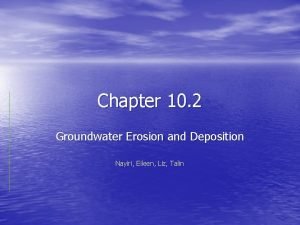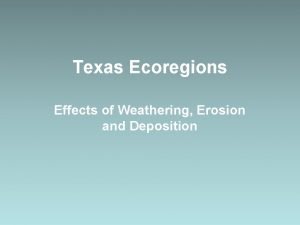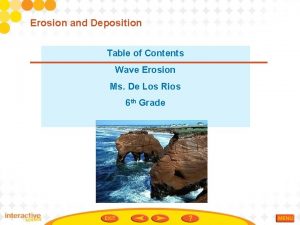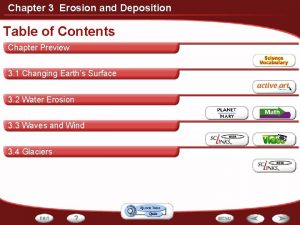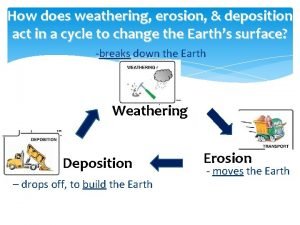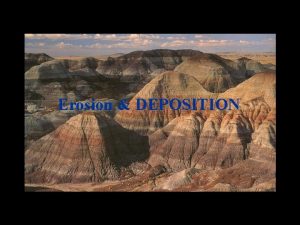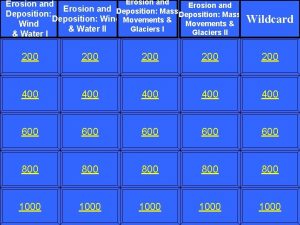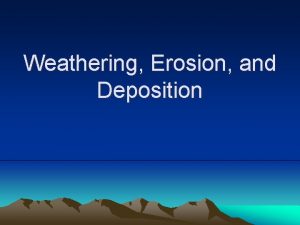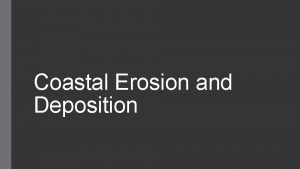Chapter 10 2 Groundwater Erosion and Deposition Nayiri







- Slides: 7

Chapter 10. 2 Groundwater Erosion and Deposition Nayiri, Eileen, Liz, Talin

Dissolution By Groundwater • • The process by which carbonic acid forms and dissolves calcium carbonate has three chemical equations. In the first, carbon dioxide and water combine to form carbonic acid. CO 2 + H 2 O H 2 CO 3 In the second, Carbonic acid (H 2 CO 3) molecules in the water split into hydrogen ions (H+) and bicarbonate ions (HCO 3 -) H 2 CO 3 H+ + HCO 3 - In the third, the hydrogen ions react with calcium carbonate and dissolve it. Ca. CO 3 + H+ Ca 2+ + HCO 3 - For every carbon dioxide molecule dissolved in groundwater, one hydrogen ion is produced and one calcium carbonate molecule is dissolved. The resulting calcium (Ca 2+) and bicarbonate (HCO 3 -) ions are then flushed away by the groundwater. Eventually, they precipitate out somewhere else. Precipitation of calcium carbonate occurs when the groundwater evaporates or when the gas carbon dioxide diffuses out of the water.

Caves • Cave – is a natural underground opening with a connection to • • • earth’s surface Some caves form three dimensional mazes of passages, shafts, and great chambers that stretch for kilometers. All caves of similar sizes are formed when underground water dissolves limestone. As groundwater passes through the cracks and joints of limestone formations, it dissolves the adjacent rocks and enlarges these passages to form an interconnected network of openings.

Karst Topography • Sinkholes, water tables, sinking streams, and water filled caves are the characteristic surface features produced by the dissolution of limestone.

• Sinkholes – depression in the ground caused by the • • • collapse of a cave or by the direct dissolution of bedrock by acidic rain or moist soil. Another type of feature forms when a surface stream drains into a cave system, continues underground, and leaves a dry valley above. Limestone regions that have sinkholes, sinks, and sinking streams are said to have Karst topography. The word Karst comes from the name of a limestone region in Croatia where these features are well developed.

Hard Water • Hard Water – water that contains high concentrations of calcium, magnesium, or iron. • Hard water is common in limestone areas where the groundwater is nearly saturated with calcium carbonate. • Soft Water – water that contains few dissolved ions.

Natural Deposits • The most remarkable deposits produced by groundwater are the • • dripstone formations that decorate many caves above the water table. Each drop of water hanging on the ceiling of a cave loses some of its carbon dioxide and deposits a tiny amount of calcium carbonate. Over the years, these deposits gradually form cone shaped or cylindrical structures called Stalactites that hang from the cave’s ceiling like icicles. As the water drops splash to the floor of the cave, they build mound shaped dripstone deposits called Stalagmites underneath stalactites. Travertine – type of limestone that composes dripstone formations.
 Groundwater erosion and deposition
Groundwater erosion and deposition A tiny groove in soil made by flowing water
A tiny groove in soil made by flowing water How does weathering affect the gulf coast plains?
How does weathering affect the gulf coast plains? Piney woods weathering
Piney woods weathering Why is there little erosion in the piney woods?
Why is there little erosion in the piney woods? An area of wave-washed sediment along a coast is a(n)
An area of wave-washed sediment along a coast is a(n) Weathering erosion and deposition
Weathering erosion and deposition Weathering erosion and deposition
Weathering erosion and deposition
